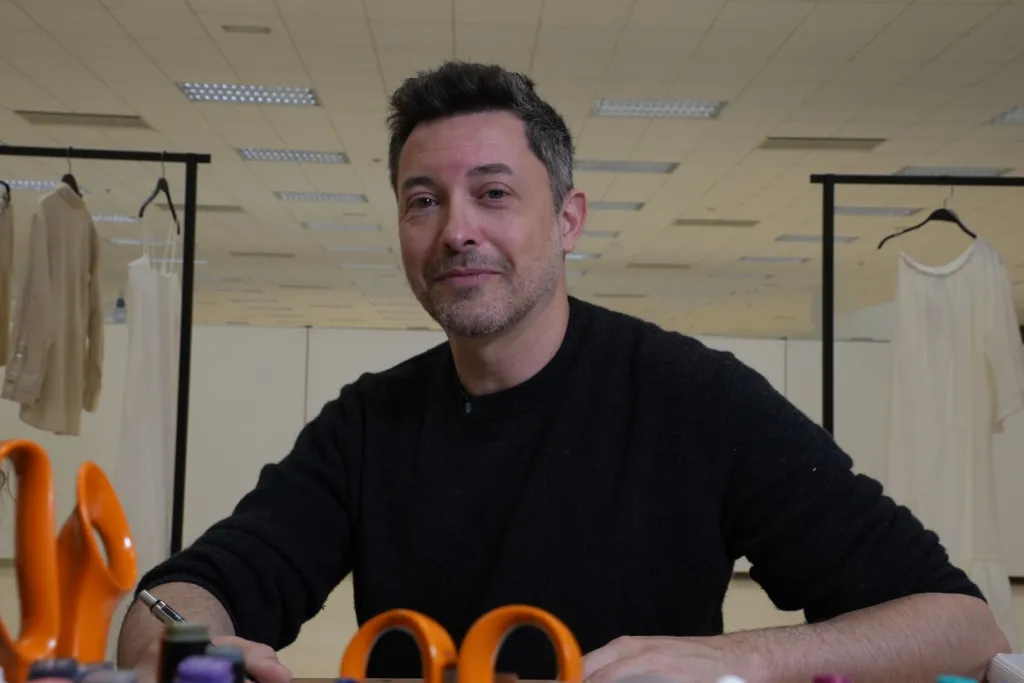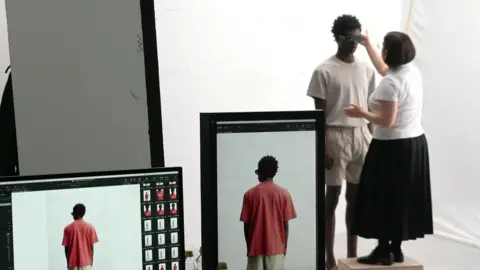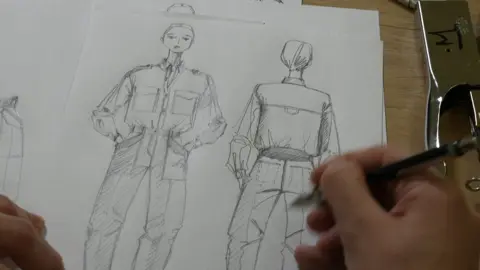
It's going to be a very sexy summer, a touch of romantic, cowboy and rock and roll.
That's according to Mehdi Sousanne, at least. And he should know. He's a designer for Zara who helps create the clothes for a brand that's one of the most successful stories in High Street fashion.
Zara is owned by Inditex, the world's biggest fashion retailer, which runs a string of store chains including Massimo Dutti and Pull & Bear.
It relies on 1,800 suppliers across the world, but nearly all the clothes are brought to Spain where the company is based, to be despatched to stores in 97 countries.
Zara doesn't advertise and rarely gives interviews. But as it marks 50 years since the opening of its first store, I've come to its vast campus in Galicia to meet the boss and workers for a rare glimpse into how the secretive brand operates.
It's a time when the company finds itself having to navigate fast-changing markets, with growing competition from ultra-cheap online players Shein and Temu, who ship their goods direct from China, as well as uncertainty surrounding US tariffs.
But Oscar Garcia Maceiras, Inditex's CEO, says US President Donald Trump's tariffs won't disrupt its supply chains or change Zara's plans to expand further in the US, now its second biggest market.
"Bear in mind that for us, diversification is key. We are producing in almost 50 different markets with non-exclusive suppliers so we are more than used to adapt ourselves to change," he tells me.

The business has certainly adapted and grown since its first store opened a short drive away in the town of A Coruna.
It now has 350 designers, with the staff coming from some 40 different countries.
"There are no rules in general. It's all about feelings," says Mehdi, who works on delivering the key pieces for the season.
He says inspiration can come from anyone ranging from the "street" to the cinema as well as the catwalks. He likes to sketch his ideas once an all-important mood board has been created.
In the pattern cutting room, the designs are turned into paper samples, and are pinned on to mannequins. Dozens of seamstresses then run up the first fabric samples on the spot for a first fitting.
Pattern maker Mar Marcote has been with the business 42 years and still uses a magnifying glass to examine each item of clothing before it finally goes into production.
"When you finish the item and see that it looks good, and then sometimes sells out, it's marvellous," she says.

Zara is a business that has changed the way we shop.
In the old days, retailers released just two main collections a year, Spring/Summer and Autumn/Winter. For decades, most chains have outsourced manufacturing to lower-cost factories in the far east with the clothes arriving up to six months later.
Zara went against conventional wisdom by sourcing a lot of its clothes closer to home and changing products much more frequently. That meant it could respond much faster to the latest trends and drop new items into stores every week.
Just over half of its clothes are made in Spain, Portugal, Morocco and Turkey. There's a factory doing small production runs on site at HQ, with another seven nearby, which it also owns.
As a result, it can turn around products in a matter of weeks.

More basic fashion staples are produced with longer lead times in countries like Vietnam and Bangladesh.
Logistics and data are other factors behind its success. Every piece of clothing is packaged and despatched from its distribution centres in Spain, as well as one in the Netherlands.
"What is absolutely critical is the level of accuracy," says CEO Mr Maceiras.
"It's something that allows us to make the right decision in the last possible minute, in order to assess properly the appetite from our customers, in order to adapt our fashion proposition to the profile of our customers in different locations."
In other words, getting the right products to the right shops.
At HQ, product managers then receive real-time data on how clothes are selling in stores worldwide, and – crucially – feedback from customers, which is then shared with designers and buyers, who can adjust the ranges along the season according to demand.
Unlike some other High Street rivals, it only discounts when it stages its twice-yearly sales.

But is Zara starting to lose its shine after posting slower sales growth at the start of this year?
"The key challenge for Inditex is continuing to be relevant in a fashion world that continues to get faster and cheaper," says William Woods, European retail analyst for Bernstein.
Not only are mainstream rivals like H&M, Mango and Uniqlo trying to catch up, the market has been disrupted by Shein and Temu.
Shein racked up $38bn in global sales last year, just a whisker behind Inditex.
Asked how much of a threat Shein and Temu's success poses to Zara, Mr Maceiras stresses that its business model doesn't rely on price.
"Of course, we are looking at providing our customers our products at an affordable price. But for us, it's critical to provide customers fashion that should be inspirational, with quality, creativity and sustainable."
Zara has come a long way since its founder Amancio Ortega started the business.
The company is still majority-owned by his family and his daughter Marta is now chairwoman of the group.
Now aged 89, Mr Ortega remains famously reclusive but still pops in, according to Mr Maceiras.
"He's a presence, a physical or moral presence, absolutely every day."

17 PerFlyer